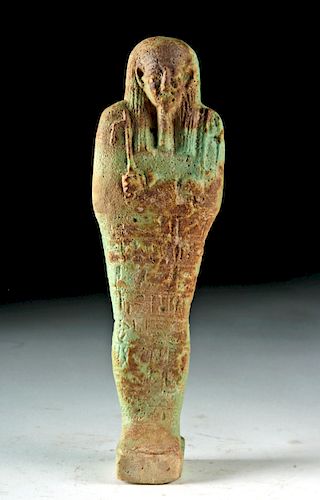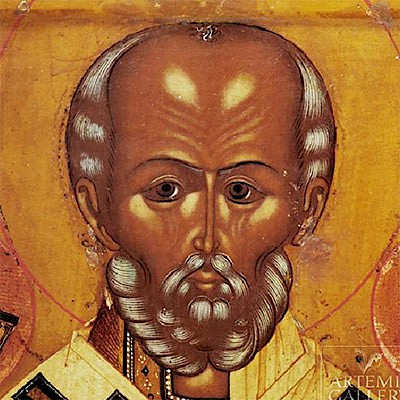Tall Egyptian Late Dynastic Faience Ushabti
Lot 3
About Seller
Artemis Fine Arts
686 S Taylor Ave, Ste 106
Louisville, CO 80027
United States
Selling antiquities, ancient and ethnographic art online since 1993, Artemis Gallery specializes in Classical Antiquities (Egyptian, Greek, Roman, Near Eastern), Asian, Pre-Columbian, African / Tribal / Oceanographic art. Our extensive inventory includes pottery, stone, metal, wood, glass and textil...Read more
Estimate:
$2,500 - $3,500
Absentee vs Live bid
Two ways to bid:
- Leave a max absentee bid and the platform will bid on your behalf up to your maximum bid during the live auction.
- Bid live during the auction and your bids will be submitted real-time to the auctioneer.
Bid Increments
| Price | Bid Increment |
|---|---|
| $0 | $25 |
| $300 | $50 |
| $1,000 | $100 |
| $2,000 | $250 |
| $5,000 | $500 |
| $10,000 | $1,000 |
| $20,000 | $2,500 |
| $50,000 | $5,000 |
| $100,000 | $10,000 |
| $200,000 | $20,000 |
About Auction
By Artemis Fine Arts
Dec 20, 2018
Set Reminder
2018-12-20 10:00:00
2018-12-20 10:00:00
America/New_York
Bidsquare
Bidsquare : Warehouse Clear Out - Ancient & Ethnographic
https://www.bidsquare.com/auctions/artemis-gallery/warehouse-clear-out---ancient-ethnographic-3742
Time to clear out the warehouse, as these lots are going, going, gone... plus a we've added a nice selection of lots brand-new to auction! Artemis Fine Arts info@artemisgallery.com
Time to clear out the warehouse, as these lots are going, going, gone... plus a we've added a nice selection of lots brand-new to auction! Artemis Fine Arts info@artemisgallery.com
- Lot Description
**First Time At Auction**
Egypt, Late Dynastic Period, 30th Dynasty, ca. 380 to 343 BCE. A beautiful, mold-formed faience ushabti covered in a pale teal-hued glaze. The figure stands in mummiform atop an integral rectangular plinth, holds a symbolic pick and hoe in crossed hands, and has a seed bag draped over its left shoulder. Almond eyes, a petite nose, puffy cheeks, cupped ears, and a false beard comprise the serene visage, and the head is framed with a striated tripartite wig. Nine horizontal lines of inscribed hieroglyphic text wrap around the torso and legs and provide a protective invocation from chapter 6 of the Egyptian Book of the Dead (or the Book of Going Forth by Day). A fabulous and sizable example from ancient Egypt! Size: 2.3" W x 7.55" H (5.8 cm x 19.2 cm).
Ushabti dolls are figures shaped like adult male or female mummies wearing traditional Egyptian headdresses. The ancient Egyptians believed that, after they died, their spirits would have to work in the "Field of Reeds" owned by Osiris, the god of the underworld. As a result, they are frequently depicted with arms crossed, typically holding picks and hoes, with baskets on their backs. This meant that the task of agricultural labor was required by all members of society, from workers and scribes to aristocrats and even pharaohs. The wealthier nobility in Egyptian society were able to have ushabti made of faience, though wood was a more economical option for members of lower classes.
While the text on this ushabti has not been translated, it likely follows an abbreviated template from chapter 6 of the Egyptian "Book of the Dead" (literally translated as the "Book of Going Forth by Day"). It pays homage to the "sehedj Osiris" (meaning the "illuminated" Osiris) so that the deity looks kindly and mercifully upon the soul of the deceased when entering his sacred gardens in the afterlife. Shorter inscriptions like the one on this example would simply bear Osiris' name as well as the name and title of the deceased, though longer translations present the deceased as ready and willing to tend to the Field of Reeds when called upon.
Provenance: private East Coast, USA collection
All items legal to buy/sell under U.S. Statute covering cultural patrimony Code 2600, CHAPTER 14, and are guaranteed to be as described or your money back.
A Certificate of Authenticity will accompany all winning bids.
We ship worldwide and handle all shipping in-house for your convenience.
#139672Fading to hieroglyphic text, minor nicks to base, body, and head, with fading and browning to original glaze coloration, light pitting, and one small excision near chin, otherwise intact and excellent. Light earthen deposits throughout.Condition
- Shipping Info
-
All shipping is handled in-house for your convenience. Your invoice from Artemis Gallery will include shipping calculation instructions. If in doubt, please inquire BEFORE bidding for estimated shipping costs for individual items.
-
- Buyer's Premium



 EUR
EUR CAD
CAD AUD
AUD GBP
GBP MXN
MXN HKD
HKD CNY
CNY MYR
MYR SEK
SEK SGD
SGD CHF
CHF THB
THB















